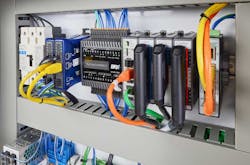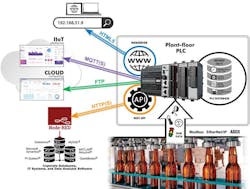The PLC Breaks Out!
At A Glance:
- As end-users take advantage of more capable PLCs, they must also consider security.
- By increasing the overall computing power of PLCs, controller vendors have made room for additional capabilities.
- Improvements in computing power have created a sophisticated PLC that can synchronize servo drives or control complex process loops while transmitting data and supporting an HMI.
Anyone who has served in the military or even a large company understands the concept of hierarchy—it identifies who’s in charge, the chain of command and how each individual fits in that structure. Some people find security in the structure, while others with ambition can feel stifled. Similar situations apply in industrial automation. A hierarchical structure defines what type of equipment goes where, and what actions are supposed to happen at each level. This approach is explained in detail by the Purdue Enterprise Reference Architecture (Fig. 1).
It puts process and field devices at the bottom, control equipment in the middle and enterprise information technology (IT) systems at the top. Operational technology (OT), with its PLCs, generally exists at the basic control level where they interface with field devices, execute control loops and control motion. When there is a need to send data to higher-level systems, it must be passed up the chain of command, moving from layer to layer.
This situation has two major faults:
- It calls for a lot of developer effort and computing resource overhead with multiple communication protocols.
- It does not recognize or utilize the growing capabilities of today’s generation of PLCs.
Classic industrial automation architectures represent concepts and equipment limitations of the 1990s. PLCs of that era were less powerful and therefore had to be specialized and focused to perform specific high-speed control functions. Higher-level systems were required to provide more advanced data-processing capability. But moving data between the lowest and highest levels called for a significant effort.
Users generated custom code configurations to select, arrange and manage data. A lot of parts and programming were frequently involved: PLCs, gateways, PCs, software packages, network configuration and supporting code. Even when data connectivity could be patched together, it was often at the expense of security. Traditionally, PLCs had few (if any) cybersecurity provisions, especially for internet-connected systems.
Change and Improvements
Much has changed in the industrial space over the past few decades. One issue is that overhead remains a problem. Plants want flatter and less-complex control systems for processes and machines. The concept of having so many layers of specialized equipment is wasteful, but can be streamlined with more versatile controllers capable of performing multiple overlapping roles. Older PLCs could not handle their high-speed requirements while being distracted by other data management functions.
Improvements in computing power (Fig. 2) mean today’s PLCs can now synchronize servo drives or control complex process loops while transmitting data and supporting a human-machine interface (HMI). A sophisticated PLC can straddle more than one level.
Second, as just noted, PLCs have come a long way—but adoption of all improvements is not uniform across vendors. Some companies have decided that traditional structures are safe and elected to remain within those constraints, even though limited communication capabilities makes integration with up- and downstream equipment difficult. Synchronization is still possible, but it is complex to implement and requires additional overhead.
By putting technological improvements to work and increasing the overall computing power of their PLCs to handle basic functions with far less sweat, some vendors have made room for additional capabilities. For example, by including a longer list of communication protocol options, a PLC can bridge over intermediate network layers and reduce the complexity of interfacing with the enterprise. Even a relatively simple PLC can operate in an environment dominated by equipment from a different vendor. Additionally, it can communicate with IT-centric assets using a representational state transfer application programming interface (REST API) or secure message queuing telemetry transport (MQTT/S) over wired or wireless networks. This is a far cry from older PLCs that only speak MODBUS.
This ability can extend even farther with IoT connectivity direct to the cloud. Even a small or medium PLC may be certified to have native connectivity to Microsoft’s Azure Platform. Certification assures users that the device is tested to work with the Azure infrastructure and provides clear documentation about how to connect. Azure offers many industrial IoT capabilities to help users visualize and optimize their operations, including:
- Cosmos DB for data storage
- Power Apps for easily building low-code solutions
- Web and mobile visualization
- Machine learning and analytics to build advanced predictive models
Consider this situation: a PLC must pass data upstream to a corporate network for advanced processing. Using the traditional approach, it moves via the chain through all the layers, possibly converted to a different protocol a time or two, and ultimately reaches its destination. The alternative is an Azure-certified PLC able to interface with an Azure IoT hub without the need of a gateway: a direct connection, less complex and with far less overhead.
Applying the Standards
Some of the most popular serial and Ethernet protocols for OT purposes include ASCII, Modbus RTU, K-Seq, Modbus TCP and EtherNet/IP. On the other hand, IT systems use protocols like SNTP DNS, MQTT, SMTP, SSL and web services. A PLC bundling these capabilities together becomes a bridge from OT to IT, creating many ways to connect new and legacy factory floor equipment to today’s enterprise systems.
When all data integration elements are built-in and reside natively in a PLC, setup is much faster. IT users typically prefer open-source solutions because they are already familiar with this approach, rather than specialized environments common to industrial products.
When these technologies are available, users can select from a range of options based on process requirements (Fig. 3). They can:
- Store data in the PLC and forward it to other systems using FTP
- Present information as web pages hosted by an internal web server
- Expose data to external clients with a REST API
- Communicate data to other systems using MQTT over TLS
The last of these options, MQTT, has risen to become a popular standard for PLC-to-cloud communications. The PLC in the field initiates conversations as outbound messages to a centralized broker, which can be on premises but is most often in the cloud. This enables two-way communications while avoiding firewall and IT management issues which would occur with many types of inbound communications.
MQTT communications are responsive, but at the same time can withstand network and communication outages commonly found at edge locations. A PLC using MQTT is ideal for transmitting data to an IIoT platform located on a cloud computing service like Microsoft Azure. Users can access the data with enterprise or mobile clients, or they can create other applications to use this PLC-sourced MQTT data.
Security and Flexibility
Improved PLC connectivity unfortunately leads to greater cybersecurity risks. Therefore, new PLCs must include built-in security features, such as:
- Closed by default to requests from the outside world
- On-board storage of username and password credentials managed by OT personnel
- IP whitelisting to control which external clients are allowed to communicate with the PLC
- Secure communication over TLS when possible
As end-users take advantage of more capable PLCs, they should ensure that these security capabilities are available and are configured properly.
Yesterday’s PLCs and other industrial automation products were largely incapable of advanced computing tasks that users want and need today, because they were specialized and limited in terms of data handling. The processing power incorporated in today’s OT digital devices provides greater capabilities for supporting IoT and analytical endeavors at the enterprise level and in the cloud. Merging proven OT-based technology with carefully coordinated IT-friendly communications and security results in a potent PLC combination. Modern PLCs can connect directly to the cloud, making it easy to break out of traditional restrictions.
Damon Purvis is the PLC product manager at AutomationDirect.com. He has more than 22 years of industrial automation experience. Previous roles have included designing and deploying automated solutions in a variety of industries and managing product development of manufacturing data management and business intelligence applications.
About the Author
Damon Purvis
PLC Product Manager, AutomationDirect.com
Damon Purvis is the PLC product manager at AutomationDirect.com. He has more than 22 years of industrial automation experience. Previous roles have included designing and deploying automated solutions in a variety of industries and managing product development of manufacturing data management and business intelligence applications.



